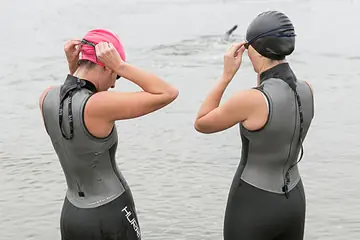The ability to swim at different speeds is also important to the learning process. As land animals, we learn to do athletic movements by committing them to muscle memory. The most accepted way is to mimic the motion as specifically as possible, with balance and stability, all in slow motion. Slow motion for someone who can't breathe well is very difficult. In fact, most people who are poor swimmers (and poor breathers—they go together) are somewhat frenetic in the water. They speed their motions up and do not complete fluid movements, which makes learning proper stroke technique almost impossible.
If you want to get better at swimming, you need to learn to breathe. The need to breathe trumps every other. It is our number one continuous need. When that need is satisfied to the point where it is automatic, and natural (again—no thinking), the ability to relax in the water can be achieved. Once a person can relax in the water, they can swim at any speed and focus on the things that will help them improve. A person will never relax until they are comfortable breathing, so if it is an issue in training, spend some more time on this piece before you move on.
More: 5 iPhone Apps for Swimmers
Getting Started: "Going Nowhere, Doing Nothing"
Here is a drill/activity best done with a partner.
1. Start in three or four feet of water (A nose clip makes it even easier, but not required).
2. Tell the kids we're going to have a contest to see who can "fall asleep" in the water.
3. Everyone finds a space where they can put their face down while breathing through the snorkel. Instruct them to lay down (float) with their arms out and slightly up with their hands about even with their head. They can move their hands a little bit to stay in one place and move their feet a little to keep them near the surface, but primarily you're trying not to move at all.
4. Each set of partners will take turns timing each other to see how long they can remain in a prone floating position.
More: 2 Pull Drills for Faster Freestyle
Once you master this skill, you can move on. If you haven't mastered this skill, don't think "I'll do this later" or "I don't have time to breathe naturally". Do not move on. Again, when your need for air is satisfied, you can learn to relax and focus on the most important areas of training.
Moving On:
People who have mastered this can now transition into something that is a bit more challenging.
1. Start from the "falling asleep" or prone position and begin to kick your feet.
2. Beginning slowly, bring the kick to a soft continuous boil and make your way down the pool. Your arms should remain motionless by your side as you move down the pool.
3. When you master this transition and balance you have established the cornerstone of efficient swimming.
- 2
- of
- 2











Discuss This Article